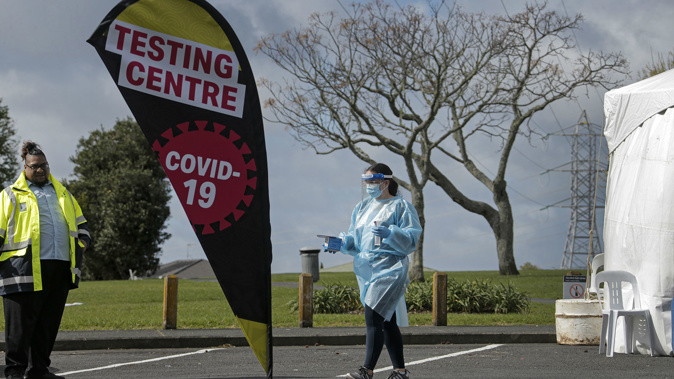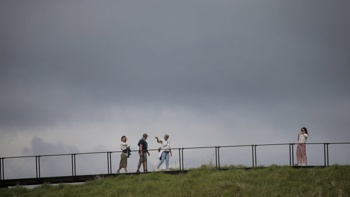
Experts have compared Australia's Omicron experience with our own to conclude New Zealand needs to be strengthening its public health measures, rather than relaxing them.
Kiwis learn tomorrow whether the country will shift to the orange traffic light setting: a move that would remove capacity limits but still require masks to be worn at many indoor venues.
Ahead of that decision, Otago University public health experts Dr Jennifer Summers and professors Michael Baker and Nick Wilson have published a commentary calling for urgent and widespread improvements to our pandemic response – namely with higher vaccination coverage and strong mask measures.
As for what New Zealand might expect on the other side of our Omicron peak, the researchers turned across the Tasman.
Omicron took root in Australia's communities around a month and a half earlier than in Aotearoa.
But in both cases, the subsequent wave of infections and hospitalisations proved much larger than either country had seen before.
"When we observed the first Omicron wave in Australia in January, we had a reasonable idea of what New Zealand could expect in terms of case load and what this could mean for the health system," Summers told the Herald.
"What we see now is that Australia had a higher hospitalisation rate per 100,000 population at its peak of the first Omicron wave compared to New Zealand."
However, when the researchers broke out Auckland's Omicron wave, which peaked between one and four weeks ahead of the rest of New Zealand, that regional ratio proved much higher, with the city's seven-day case average peaking at about 637 per 100,000 in early March.
By contrast, Australia's mid-January peak reached a seven-day case average of about 423 per 100,000, while a late-March peak in the rest of New Zealand hit a high of about 410 per 100,000.
Since then, daily case numbers in Auckland have fallen to below the 2000-mark, and were expected to keep trending downward for a period.
For the rest of New Zealand, daily reported cases have been averaging around 11,000, with regional variation in the timing of peaks, and a slightly more drawn-out national wave than that experienced in Australia.
Looking at hospitalisation rates, they found peak numbers of patients with Covid-19 in Australia reached nearly 5400 in late January – and a similar two-week lag was observed in Auckland, with a peak of more than 630 hospitalisations in mid-March.
Again, the researchers found Auckland's hospitalisation rate per 100,000 was much higher than Australia's and the rest of New Zealand's - something that may have been partly down to household crowding and a higher prevalence of co-morbidities.
Still, the nature of those hospitalisations mattered.
On January 21, Australia recorded a peak-high of 424 intensive care unit (ICU) beds occupied, compared with 33 in New Zealand on March 21.
The researchers had earlier suggested New Zealand might experience a peak in ICU cases comparable per capita with Australia – or equivalent to about 90 – but that high rate never eventuated.
More investigation was needed to find out why, they said, but the booster shot likely played a part, given only around 20 per cent of Australia's population had received the dose at the time of its Omicron peak, compared with around 50 per cent booster coverage during New Zealand's.
While Australia now appeared to be suffering a second wave, the researchers pointed to the impact of the faster-spreading BA.2 sub-variant, which has been driving similar repeat surges in countries that were hit with Omicron's original BA.1 type early.
Because BA.2 arrived here soon after the original BA.1 subtype, New Zealand has effectively been experiencing two Omicron outbreaks at once.
Although that could mean another flare-up here might prove smaller compared with other countries, Summers pointed to the danger of subsequent waves after that – and perhaps fuelled by new variants.
"To prepare for this likely scenario, public health protections need to be strengthened in New Zealand, not lessened," she said.
"And there are many ways in which this could be achieved."
That included lifting vaccination rates across all age groups – with a particular focus on high-risk individuals and communities – as well as offering a fourth dose to the vulnerable, reducing the minimum age for boosters to 16 years, and cutting the time between child doses.
As well, the researchers saw a need to improve ventilation in schools and other indoor places, and ensure that masks were of high-quality and properly worn inside public venues.
More broadly, New Zealand needed to beef up its Covid-19 surveillance – something scientists have argued we're now falling short on – and upgrade its protection framework to be adaptable to new variants like the newly-discovered XE.
Baker said he considered today's traffic light system "a bit of a left-over" from battling waves that had already hit us.
"Now, I think we should be thinking much more about indoor environments, where much of the transmisson occurs, and how we can dampen this risk down to get through winter," he said.
"While it's true that the delay in BA.2 arriving here made for a big difference between us and Australia, we need to remember that the other two driving forces – waning immunity and lightening restrictions – are just as relevant here as they are everywhere."
Take your Radio, Podcasts and Music with you









